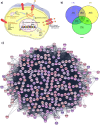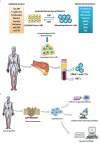Circulating tumor cell markers for early detection and drug resistance assessment through liquid biopsy
- PMID: 40260304
- PMCID: PMC12009936
- DOI: 10.3389/fonc.2025.1494723
Circulating tumor cell markers for early detection and drug resistance assessment through liquid biopsy
Abstract
Circulating tumor cells (CTCs) are cancerous cells that extravasate from the primary tumor or metastatic foci and travel through the bloodstream to distant organs. CTCs provide crucial insights into cancer metastasis, the evolution of tumor genotypes during treatment, and the development of chemo- and/or radio-resistance during disease progression. The process of Epithelial-to-mesenchymal transition (EMT) plays a key role in CTCs formation, as this process enhances cell's migration properties and is often associated with increased invasiveness thereby leading to chemotherapy resistance. During the EMT process, tumor cells lose epithelial markers like EpCAM and acquire mesenchymal markers such as vimentin driven by transcription factors like Snail and Twist. CTCs are typically identified using specific cell surface markers, which vary depending on the cancer type. Common markers include EpCAM, used for epithelial cancers; CD44 and CD24, which are associated with cancer stem cells; and cytokeratins, such as CK8 and CK18. Other markers like HER2/neu and vimentin can also be used to target CTCs in specific cancer types and stages. Commonly, immune-based isolation techniques are being implemented for the isolation and enrichment of CTCs. This review emphasizes the clinical relevance of CTCs, particularly in understanding drug resistance mechanisms, and underscores the importance of EMT-derived CTCs in multidrug resistance (MDR). Moreover, the review also discusses CTCs-specific surface markers that are crucial for their isolation and enrichment. Ultimately, the EMT-specific markers found in CTCs could provide significant information to halt the disease progression and enable personalized therapies.
Keywords: circulating tumor cells; early detection; liquid biopsies; multidrug resistance; nanotechnology; tumor plasticity.
Copyright © 2025 Yadav, Rajendrasozhan, Lajimi, Patel, Heymann and Prasad.
Conflict of interest statement
The authors declare that the research was conducted in the absence of any commercial or financial relationships that could be construed as a potential conflict of interest.
Figures


Similar articles
-
EpCAM-independent isolation of circulating tumor cells with epithelial-to-mesenchymal transition and cancer stem cell phenotypes using ApoStream® in patients with breast cancer treated with primary systemic therapy.PLoS One. 2020 Mar 26;15(3):e0229903. doi: 10.1371/journal.pone.0229903. eCollection 2020. PLoS One. 2020. PMID: 32214335 Free PMC article.
-
Epithelial to mesenchymal transition markers expressed in circulating tumour cells of early and metastatic breast cancer patients.Breast Cancer Res. 2011 Jun 10;13(3):R59. doi: 10.1186/bcr2896. Breast Cancer Res. 2011. PMID: 21663619 Free PMC article.
-
Clinical and biological significance of circulating tumor cells in cancer.Mol Oncol. 2016 Mar;10(3):408-17. doi: 10.1016/j.molonc.2016.01.010. Epub 2016 Feb 10. Mol Oncol. 2016. PMID: 26899533 Free PMC article. Review.
-
Targeting circulating tumor cells to prevent metastases.Hum Cell. 2024 Jan;37(1):101-120. doi: 10.1007/s13577-023-00992-6. Epub 2023 Oct 24. Hum Cell. 2024. PMID: 37874534 Free PMC article. Review.
-
Circulating tumour cells escape from EpCAM-based detection due to epithelial-to-mesenchymal transition.BMC Cancer. 2012 May 16;12:178. doi: 10.1186/1471-2407-12-178. BMC Cancer. 2012. PMID: 22591372 Free PMC article.
References
-
- Siegel RL, Miller KD, Wagle NS, Jemal A. Cancer statistics, 2023. CA: A Cancer J Clin. (2023) 73:17–48. 10.3322/caac.21763 - PubMed
Publication types
LinkOut - more resources
Full Text Sources
Research Materials
Miscellaneous

